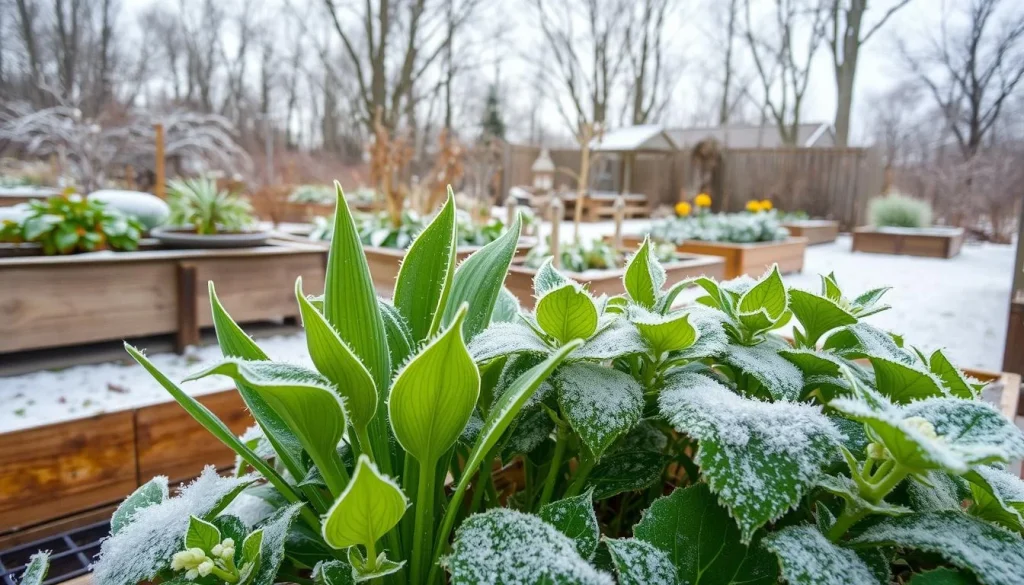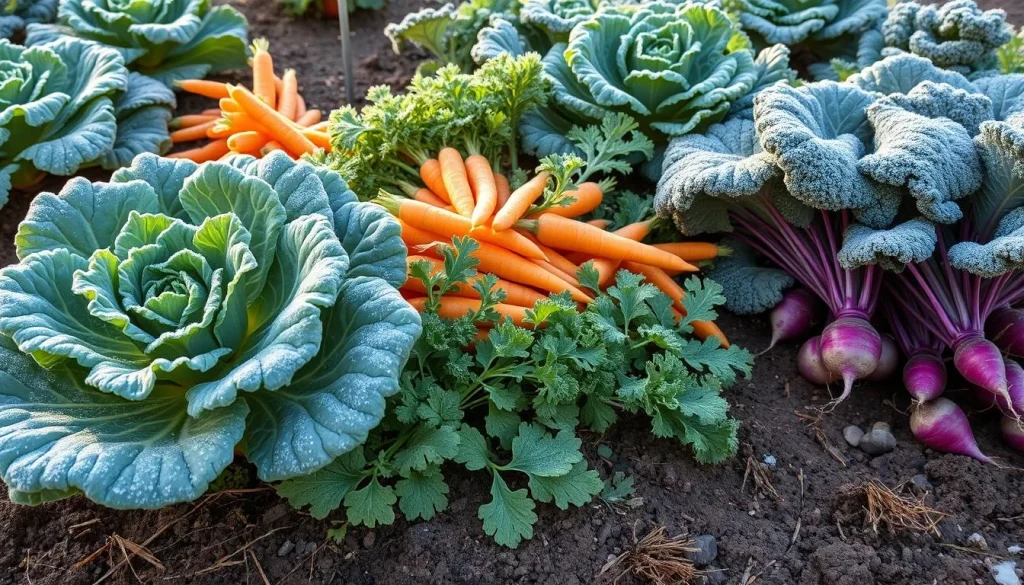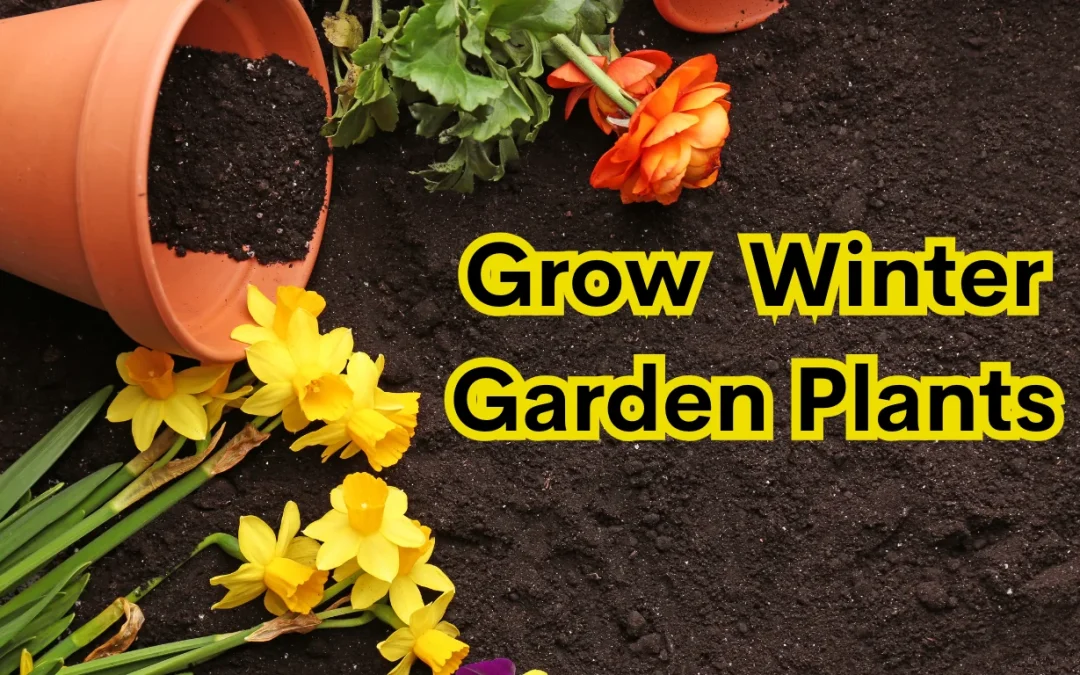As the days get shorter and it gets colder, starting a winter garden might seem hard. But, the cold months are perfect for growing winter garden plants. These plants can add color and life to your garden when it’s usually quiet.
Exploring gardening in winter reveals a calm beauty that’s unique to this season. It invites gardeners to see the beauty in the cold. This guide will help you start a winter garden. It will be filled with strong plants that stand up to the cold and make your garden look amazing.

A serene winter garden scene with vibrant green plants peeking through a light dusting of snow, delicate frost on leaves, wooden garden beds, and a background of leafless trees under a soft gray sky, showcasing a cozy and inviting atmosphere for winter gardening.
Key Takeaways
- Understand the unique opportunities that winter gardening provides.
- Learn about the types of plants that can be grown in a winter garden.
- Discover the beauty and benefits of maintaining a garden through the colder months.
- Gain confidence with essential tips for starting your own winter gardening project.
- Recognize the importance of selecting the right plants for success in winter climates.
Table of Contents
Understanding the Basics of Winter Gardening
When it gets cold and dark, some gardeners think it’s time to stop gardening. But, with the right tips, winter can be a great time to garden. We’ll explore what to grow in winter and how to keep your garden alive and beautiful, even when it’s chilly.
What is Winter Gardening?
Winter gardening means growing plants in the cold months. It uses special techniques to keep plants safe from frost. You choose plants that do well in the cold and use things like cold frames to help them grow.
Benefits of Growing Plants in Winter
Gardening in winter lets you grow food all year. It also means fewer pests and weeds. Plus, you get to enjoy a colorful garden in the winter, making it a fun activity.
Challenges of Winter Gardening and How to Overcome Them
Winter gardening faces big challenges like frost and less sunlight. Frost can hurt plants, and less sunlight makes it hard for them to grow. Here are some ways to beat these problems:
- Choose plants that can handle the cold.
- Use cloches and row covers to protect plants from frost.
- Put plants in sunny spots or use mirrors to reflect sunlight.
Knowing what can I grow in winter and how to care for these plants can help keep your garden lively all year.
Preparing Your Garden for the Winter Season
As winter approaches, it’s key to get your garden ready for winter garden plants. This effort keeps your outdoor space lively and productive even in the cold. We’ll cover essential steps to get your garden beds, soil, and environment ready for the best plants to plant in winter.
Start by checking your garden’s state. Clear out weeds and debris to avoid pests and diseases that worsen in winter. Then, enrich the soil with compost or manure. This boosts water retention and protects roots from cold.
- Amend the soil: Add organic matter to make the soil better.
- Choose the right location: Place beds where they get the most sunlight.
- Apply mulch: Mulch helps keep roots warm in cold weather.
- Plan for water drainage: Avoid waterlogged soil, which can harm plants in winter.
It’s also crucial to pick the best spot for your winter garden plants. They need enough light and protection from harsh weather. Consider using cloches or row covers for extra warmth and frost protection. Here’s a quick guide to find the perfect spot for plants to plant in winter:
| Area | Sun Exposure | Wind Protection | Proximity to Perennials |
|---|---|---|---|
| Northern side | Low | High | Far |
| Eastern side | Medium | Medium | Close |
| Western side | High | Low | Close |
| Central garden | High | Low | Close |
Getting your garden ready for winter helps keep your plants alive and prepares for spring. By carefully following these steps, your garden will be perfect for plants to plant in winter. It will be ready to bloom beautifully in the spring, showing off your garden’s strength and beauty.
Selecting the Right Winter Garden Plants
Even when it gets cold, your garden doesn’t have to look dull. Picking the right winter plants for garden settings is key. You need a mix of annuals and perennials that can handle the cold and keep your garden lively.
Look for plants that not only survive but also bloom in the cold. We’ll explore the best plants for winter and how they keep your garden looking good.
Hardy Plants for Chilly Climates
Hardy plants are essential for a winter garden. They can handle freezing temperatures. Evergreens like juniper and holly keep their leaves and color, making your garden look alive even in winter.
Perennials vs. Annuals: What’s Best for Winter?
Knowing the difference between perennials and annuals is crucial. Perennials live for more than two years and bloom every season. They’re great for a consistent garden. Annuals, on the other hand, bloom once and need replanting every year. They add color even in the coldest months.
Choosing between perennials and annuals depends on your garden and plans. Perennials last longer, but annuals offer design flexibility and can change with the seasons.
Essential Tools and Equipment for Winter Gardening
Gardening in winter needs determination and the right tools. These tools make winter gardening enjoyable. Here’s a list of must-haves for a thriving winter garden.
Hand tools that don’t freeze up and covers for frost protection are key. With the right gear, winter gardening becomes less of a challenge.
- Insulated Gloves: Keep your hands warm and protected from the cold, wet environment.
- Sturdy Spade and Trowel: For digging in frozen or semi-frozen soil, choose tools with an ergonomic design to reduce strain.
- Pruning Shears: Essential for cutting back dead or overgrown branches, ensuring your plants stay healthy throughout the season.
- Greenhouse or Cold Frame: Create a microclimate to give your plants a better chance at survival.
- Frost Cloths and Plant Blankets: Protect sensitive plants from frost damage with specially designed covers.
- Watering Can with a Long Spout: The long spout helps in watering the base of the plants without disturbing the cold air around the foliage.
Knowing how to use these tools can improve your winter gardening. For example, frosted plants need gentle care. Tools like the long spout watering can are essential.
| Tool | Use | Benefit |
|---|---|---|
| Insulated Gloves | Plant Handling | Prevents frostbite, keeps hands functional |
| Sturdy Spade | Soil Work | Enables digging in stiff soils |
| Pruning Shears | Pruning Overgrowth | Maintains plant health |
When you aim for a thriving winter garden, these tools are your allies. The right tools make your work easier and ensure a strong winter garden.

“An assortment of winter gardening tools laid out on a snowy surface, featuring a sturdy spade, a pair of insulated gardening gloves, a wooden-handled trowel, a hand pruner, and a seedling tray, all surrounded by frost-covered plant pots and winter vegetables like kale and carrots, with a soft winter light illuminating the scene.”
Get more information about Growing Crops:
- ????Grass Seed to Growing
- ????Growing Eucalyptus
- ????Garlic Growing
Tips for Planting and Maintaining Plants in Winter
As winter comes, garden lovers face new challenges. The right winter gardening tips can keep your garden alive and growing. This guide will help you prepare the soil and protect plants from cold.
Soil Preparation for Cold Weather
Getting your soil ready for winter is key to keeping plants healthy. Add compost or well-rotted manure to improve soil. This makes it better at holding water and nutrients, helping plants stay strong in the cold.
Watering Practices for Winter Plants
Winter watering is different from summer. Plants need less water because they grow slower and lose less moisture. But, make sure the soil doesn’t dry out, especially on sunny days. Water in the midday when it’s warmer to avoid freezing.
Protecting Plants from Frost and Snow
Keeping plants safe from cold and frost is crucial. Use cloches, frost blankets, or build a cold frame to keep them warm. Planting in sunny spots helps too, as it traps heat during the day.
| Protection Method | Benefits | Best Used For |
|---|---|---|
| Cloches | Portable protection, easy to use | Small plants, newly sprouted seedlings |
| Frost Blankets | Insulates against frost, allows light penetration | Bedded plants, rows of vegetables |
| Cold Frames | Creates microclimate, extends growing season | Herbs, cold-tolerant vegetables |
By following these winter gardening tips, your garden can stay healthy and lively. Paying attention to winter care will help your garden not just survive but flourish.
Winter Garden Plants: What to Grow in the Cold Months
As winter comes, gardeners start thinking about what to grow. They look at what crops grow well in Georgia. This section will show you the best vegetables, herbs, and flowers for the cold months. It’s based on Georgia’s special climate.
Vegetables That Thrive in Winter
- Kale – Known for its frost-tolerant capabilities
- Collards – Another robust green that grows sweeter with a touch of frost
- Garlic – Perfect for planting in the fall for a late spring harvest
- Carrots – Their sweetness is enhanced when matured in cold weather
Herbs and Spices Suited for the Cold
- Rosemary – Not only survives but thrives during Georgia winters
- Thyme – A versatile herb that is resistant to cold
Flowering Plants That Bloom in Winter
- Winter pansies – Known for their resilience and ability to bloom in full color even in the colder months
- Camellias – Add a splash of color to your winter garden with these beautiful flowers, which are well-suited to Georgia’s climate

A vibrant winter garden scene in Georgia, showcasing lush green kale, bright orange carrots, and rich purple turnips growing in neatly arranged rows. Include a backdrop of mild winter sunlight illuminating the garden, with frost-kissed leaves sparkling. Capture the earthy soil texture and a few scattered pine needles, emphasizing the contrast between the cold season and the thriving plants.
Maximizing Sunlight and Heat for Your Winter Plants
To make your winter garden a success, use every bit of natural light and warmth. Winter days have less daylight and weaker sun. But, with the right planning, you can still grow great plants. Here are some tips to help you make the most of sunlight and warmth.
- Position: Put your garden in a spot that gets lots of sunlight. South-facing areas usually get the most sun.
- Reflective Surfaces: Use reflective mulches or mirrors to bounce more light onto your garden. This helps during the day.
- Structures: Think about using cold frames or greenhouses. They keep heat in during the day and protect from cold at night.
Also, knowing where the sun goes in winter helps you arrange plants for the best sunlight. Winter sun is shorter and weaker. Even small shadows can block a lot of sunlight.
| Structure | Benefits | Considerations |
|---|---|---|
| Cold Frames | Traps heat, protects from frost | Must be opened on sunny days to avoid overheating |
| Greenhouses | Extended growing season, controls environment | Requires heating in extreme cold |
| High Tunnels | Flexible, enhances plant growth | Ventilation needed to manage temperature and humidity |
Getting the right amount of sunlight and warmth for your plants in winter is key. It helps them grow well and thrive in the cold.
Dealing with Pests and Diseases in the Winter Garden
Keeping your winter garden healthy means watching out for pests and diseases. Gardening in winter can be tough, but with the right winter garden plants care, your plants can do well. This part talks about common problems and how to solve them to keep your garden healthy.

A serene winter garden scene showcasing healthy winter plants, intricate details of leaves dusted with frost, protective coverings like burlap and row covers, natural remedies such as neem oil and garlic spray nearby, wooden plant beds with rich soil, soft snowflakes falling gently around, vibrant greens contrasting with the white snow, a sense of tranquility and care in the atmosphere.
Common Winter Pests and How to Prevent Them
Even when it’s cold, pests can still harm your winter garden plants care. Watch out for aphids, slugs, and mice. To keep them away, use natural methods like introducing ladybugs to eat aphids. You can also use barriers to stop slugs and rodents.
- Keep your garden clean to avoid attracting rodents.
- Use mesh barriers to protect your plants.
- Encourage beneficial insects to help control pests.
Winter Diseases in Plants and Treatment Options
Fungal infections don’t stop in winter, and damp weather can make them worse. Diseases like powdery mildew and botrytis are common in winter’s damp and cloudy weather. To fight these, make sure plants have good air flow and remove any sick parts quickly.
- Space plants well to improve air flow.
- Remove sick leaves to stop the disease from spreading.
- Use fungicides if natural methods don’t work.
| Pest/Disease | Signs | Preventive Measures | Treatment Options |
|---|---|---|---|
| Aphids | Stunted growth, distorted leaves | Introduce ladybugs | Insecticidal soap |
| Slugs | Silver trails, holes in leaves | Physical barriers, copper tape | Organic baits |
| Botrytis | Gray mold on plants | Reduce humidity, adequate spacing | Fungicide sprays |
| Powdery Mildew | White powdery spots on leaves | Good air circulation | Sulfur-based sprays |
Incorporating Winter Plants into Landscape Design
Turning your garden into a winter wonderland is more than just picking tough winter plants for garden types. It’s about mixing them into your garden’s look in a smart way. This part shares tips and ideas on how to blend these plants into your garden’s design.
Using color contrasts and textures is a great idea. Winter plants for garden often have vibrant colors like greens, reds, and purples. These can be arranged to make eye-catching patterns, even on the coldest days.
Also, placing plants wisely based on winter sunlight is key. Put plants needing sunlight in sunny spots and those okay with shade in darker areas. This makes your garden look alive and healthy.
| Plant Type | Color | Texture | Light Requirement |
|---|---|---|---|
| Evergreen Shrubs | Deep Green | Bushy | Low-medium |
| Winter-blooming Flowers | Variety of Colors | Soft/Silky | High |
| Ornamental Grasses | Golden, Brown | Feathery | Medium |
By picking the right winter plants for garden and thinking about where to put them, you can make a magical winter garden. It will be both strong and beautiful.
Conclusion
As we wrap up our look at winter garden plants, we hope to have sparked your interest in winter gardening. It’s important to know that winter plants can be just as beautiful and useful as those in summer. With the right plants and care, you can enjoy fresh food and colorful gardens even in cold weather.
The key to a successful winter garden is choosing hardy plants and taking good care of them. From preparing the soil to planting and maintaining, each step helps create a beautiful winter garden. This guide aims to give you the tools and confidence to grow a strong and productive garden in the cold months.
We hope this guide has inspired you to see winter as a chance to grow and create. Start your winter gardening journey with excitement, using the tips and advice we’ve shared. Let the cold season be a chance to show off your gardening skills, knowing that gardening rewards keep coming, even when it’s chilly.
FAQ
What is Winter Gardening?
Winter gardening is growing plants in the cold months. It uses special plants and methods to handle the cold. This way, you can have fresh food all year and keep your garden looking good even when it’s cold.
What are the Benefits of Growing Plants in Winter?
Winter gardening offers many benefits. You can get fresh veggies and herbs when it’s not usually the time. It also makes your garden colorful and interesting in the cold. Plus, it’s a fun way to stay active outdoors in winter.
How Can I Overcome the Challenges of Winter Gardening?
To beat winter gardening challenges, choose plants that can handle frost. Use covers like cloches to protect them. Also, water wisely and place your garden where it gets sunlight.
How Do I Prepare My Garden for the Winter Garden plants?
Get your garden ready for winter by adding compost to the soil. Pick a sunny spot and mulch to keep roots warm. Use cold frames or greenhouses to protect plants from harsh weather.
What Plants Are Best for a Winter Garden?
Good plants for winter gardens include hardy veggies like kale and herbs like rosemary. Also, choose flowering plants like pansies that bloom in the cold.
What Tools Are Essential for Winter Gardening?
You’ll need a strong shovel, warm gloves, and a watering can. Don’t forget covers like cloches and mulch to keep things warm.
What Are Some Effective Watering Practices for Winter Plants?
Water plants in the warm part of the day to avoid freezing. Make sure the soil drains well and water less often since plants grow slower in winter.
How Can I Protect My Plants from Frost and Snow?
Use frost blankets or cloches at night and mulch to keep roots warm. Plant in raised beds or use cold frames. Move potted plants indoors or to a sheltered spot.
What Vegetables Thrive in Winter?
Root veggies like carrots and leafy greens like kale do well in winter. They’re perfect for the cold and can even taste sweeter after a frost.
Can Herbs and Spices Grow in Cold Weather?
Yes, some herbs like rosemary and thyme can grow in the cold. They need some protection from extreme cold to survive.
What Flowering Plants Bloom in Winter?
Plants like pansies and winter jasmine bloom in winter. They add color to your garden even when it’s cold.
How Can I Maximize Sunlight and Heat for My Winter Plants?
Place your garden in a sunny spot and use structures to block cold winds. Use reflective materials and warm gardening beds to keep plants cozy.
What Are Common Winter Pests and Diseases, and How Can I Prevent Them?
Winter pests include aphids and slugs, while diseases like powdery mildew can occur. Keep your garden clean, use row covers, and encourage beneficial insects. Rotate crops and treat pests when needed.
How Can I Incorporate Winter Plants into My Landscape Design?
Mix winter plants with different heights and textures for interest. Use evergreens for color and add features like ornamental grasses. This attracts wildlife and enhances your garden’s look.

